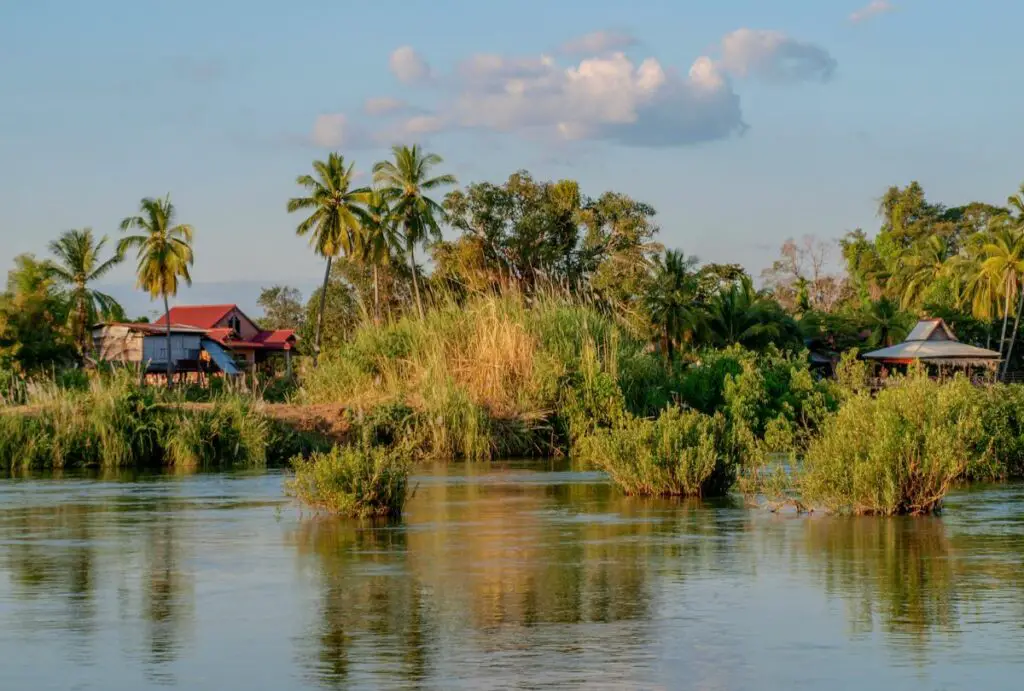Have you ever heard of this place called the 1,000 Islands, a magical place located in the south of Laos?
If you did, and if you are a digital nomad, you may wonder if it is possible to work remotely from Don Det.
Since I’ve been there twice, let me tell you about it.
Why is it Called the 4,000 Islands?

So, you’ve probably been wondering about this place they call the “4,000 Islands”, right?
It’s tucked away in the Mekong River, down in the southern part of Laos.
The name isn’t an exact headcount of islands, but more of a representation of what you see when the river gets low during the dry season.
All these small islands and sandbars just appear out of the blue, making it feel like there are a thousand of them.
What were My First Impressions of Don Det?
So, it was back in 2015 when I first visited Don Det, one of the 4,000 islands. I can say it straight away, I loved the place from the get-go.
Getting to Don Det is a bit of an adventure. It begins in Paksé, the largest town in Southern Laos, and from there you catch a bus or minivan to Nakasong. The next leg of the journey is by boat. Just 10 to 15 minutes of gliding on the Mekong River, surrounded by a multitude of islands. Quite a magical experience if you ask me.
Arriving at Don Det is like entering a different world. It’s a very small town, but so calm, so quiet.
However, I remember thinking, what on earth am I going to do here? It’s such a small place. I didn’t know yet how cool it was.
And it being an island, albeit a river one, was a bit unsettling at first. No ATM, no quick access to hospitals, or any city-like convenience.
But as it turned out, I had a great time in Don Det. So much so, that I had to return. And I did, 8 years later, in 2023.
How Reliable is the Internet in Don Det for Digital Nomads?
Now, let’s talk about one of the biggest concerns for digital nomads – the internet. In Don Det, the local WiFi can be hit or miss. But here’s the good news: my partner and I were able to use our mobile network with ease. The speed? Sufficiently fast for our needs.
During our two-week stay, we experienced a couple of power outages. They weren’t frequent, and they didn’t last long, so nothing that could seriously disrupt your work.
In a nutshell, if you aren’t looking for blazing-fast internet speeds, you’ll manage just fine in Don Det or Don Khon. After all, being a digital nomad isn’t just about working – it’s about adapting to different environments and making the most out of every experience, right?
What are the Living Conditions in Don Det?
Now, let’s talk about living conditions in Don Det. Returning after the pandemic, I found it much the same as my first visit. Sure, there were a few restaurants and bungalows that hadn’t reopened yet, but overall, the town was humming along.
We timed our visit outside of the high season which meant fewer backpackers (of which I was one back in the day), adding to the peaceful vibes. One vivid memory from my first visit was the exceptional food – it’s a tradition that’s stood the test of time. Hearty, delicious, and plentiful would be the words I’d use to describe it. If you’re ever in town, do yourself a favor and head to Crazy Gecko Restaurant. They source local ingredients and whip up the best salads and Swiss Snitzel.
As for accommodations, Crazy Gecko also has some beautiful rooms, with some facing the river. The staff treats you like royalty, making your stay all the more pleasant. You can check out the place here: Crazy Gecko
Don Det is packed with nice restaurants and accommodations, but if you’re traveling with family or prefer a bit more comfort, you might want to consider Don Khon. There are several upscale hotels there, complete with river views and swimming pools, like this one: Seng Ahloune Guesthouse
Workdays in Don Det are quite agreeable. With several scenic swimming spots on the west side of the island, breaks are something to look forward to. Just don’t be surprised if a friendly puppy decides to join you for an afternoon swim like it happened to us.
Getting around is easiest on a bicycle. Even if they’ve seen better days, they’ll get you where you need to go. Don Det and Don Khon are both ripe for exploring this way. Don Khon, with Asia’s largest waterfall, is particularly picturesque.
While dolphins once swam the waters around Don Khon, it appears they’ve moved on or, sadly, passed away. However, we’ve heard there are still dolphins in the northern part of Cambodia, not far from here.
In summary, life on Don Det and Don Khon is pretty chilled. Sure, you might hear a karaoke party from a distance, or run into a long-time western resident who seems to have made the islands their permanent home. But, all in all, it’s a peaceful and inviting place.
When is the Best Time to Go to Don Det for Remote Work?
If there’s one thing you should know about Don Det, it’s that timing matters. While it’s a fantastic place to work remotely, the experience can vary greatly depending on when you go. The best time? Try to time your visit for the dry season, from November to April. It’s when the weather is most agreeable, and you can avoid the heaviest rainfalls. But there’s a bonus to visiting during this time – it’s also outside of the high tourist season, so you’ll find fewer backpackers and a more tranquil environment to focus on your work.
How Long Should I Stay in Don Det as a Digital Nomad?
Aha! The magic question. How long should you make Don Det your digital nomad base? Well, that depends on a few factors, but if I were to give you a ballpark, I’d suggest a stay of two weeks to a month.
That gives you enough time to settle in, find your favorite work spots, and also take a break to explore the islands and soak in the beauty of the region.
However, don’t be surprised if you’re tempted to stay longer. It’s the kind of place that captures your heart and makes leaving a little harder than you’d expect.
What is the Cost of Living in Don Det for a Digital Nomad?
Don Det is not just a paradise for the senses; it’s also pretty kind to your wallet. For digital nomads on a budget, it offers a very affordable cost of living.
Of course, exact expenses will depend on your lifestyle and preferences. As a general guide, you can rent a comfortable room for as low as $10 per night. Food is also very cheap, with meals at local restaurants typically costing between $2 to $4.
For a month, considering room, food, a few local experiences, and some miscellaneous expenses, you might spend somewhere around $600 – $800, if you are looking for a low-cost experience. You’ll be closer to $1,000 – $1,500 if you are looking for higher-end accommodation and food.

